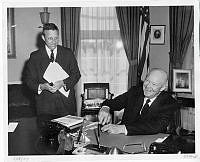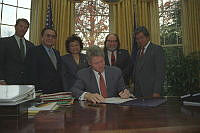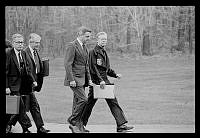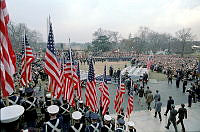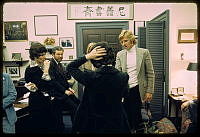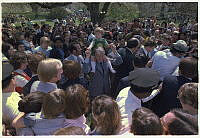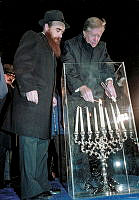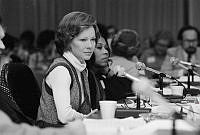Rubenstein Center Scholarship
A Brief History of the Presidential Seal

This is a preliminary 1782 version of the Great Seal of the United States by Charles Thomson, the Secretary of Congress. William Barton also made some changes to the design, such as making the stripes vertical, spreading the eagle's wings outward and upward, and using 13 arrows to represent the thirteen states.
National Archives and Records AdministrationThe Presidential Seal is synonymous with presidential authority and executive power. However, there were many different iterations, modifications, and alterations that ultimately led to the modern version that is universally recognized today. The origins of the presidential seal can be traced back to the Continental Congress. In 1782, Secretary of the Continental Congress Charles Thomson used elements from three different committees to produce his design. He then shared his sketch with William Barton, who added some minor changes to Thomson’s creation. The result was the Great Seal of the United States, which would be used to generally represent the federal government moving forward.
The Great Seal of the United States became the inspiration for presidential insignia, including seals and coats of arms that various presidents customized over the years. However, since there was no “official” seal created by legislative action or executive order, presidents used a variety of seals based on their own preferences. President James K. Polk used one eagle variation for his letterhead. President Millard Fillmore is believed to have drawn his own seal in 1850, giving the design to a Maryland postmaster named Edward Stabler to create it for him. President Abraham Lincoln also had a distinctive personal seal, which today is housed at the Abraham Lincoln Presidential Library & Museum in Springfield, Illinois. President Rutherford B. Hayes is considered the first president to use the presidential coat of arms for invitations to a White House function; one significant modification by Hayes was the turning of the eagle’s head toward the arrows. After a major renovation of the White House in 1902, President Theodore Roosevelt ordered a new presidential seal to be installed into the floor of the Entrance Hall. Philip Martiny, a French-American sculptor, used the Hayes design as a template but incorporated his own ideas and the president’s input into the final iteration. The most notable change was the engraving of the phrase, “The Seal of the President of the United States” around the edge.

This drawing by an unknown artist depicts the 1916 Flag of the President of the United States. This design was used until 1945 when President Harry Truman authorized the redesign of the seal, flag, and coat of arms.
National Archives and Records Administration, General Records of the U.S. GovernmentChief executives after Theodore Roosevelt would use this seal as well, but the coat of arms and flag were another story. Since there was no unified code or directive, the flag continued to change based on presidential prerogative. The first flag was created by the U.S. Navy in 1882 for President Chester A. Arthur. It included one variation of the presidential seal set on dark, navy blue cloth. This later prompted the U.S. Army to create its own presidential flag in 1898. It was red with four stars in the corners, and featured a large star in the middle that encompassed another version of the presidential seal. Different flags created confusion and furthered competition between the two branches of the Armed Forces, prompting President Woodrow Wilson to issue Executive Order 2390, which officially changed the design to one, navy blue presidential flag. It featured four white stars in the corners, and the eagle was outlined in white stitching looking toward the arrows of war. President Wilson suggested using Martiny’s seal in the White House floor as a template; the resulting design impressed the president so much that he later included it on the new presidential china service.1

These porcelain serving pieces, including a service plate, an entrée plate, and a ramekin, were made by Lenox China of Trenton, New Jersey, in 1918, during Woodrow Wilson's administration. Wilson's state china service was the first made for the White House in the United States. The seal in the center was taken from the president's flag that Wilson had redesigned in 1916.
White House Historical AssociationPresident Franklin Roosevelt, who served as assistant secretary of the Navy under Wilson and was deeply interested in symbols and insignia, asked military personnel and heraldry experts to redesign the presidential flag and seal toward the end of World War II. White House Naval Officer George Elsey, who was assigned to Roosevelt’s Map Room during the war, was given this task. Elsey consulted closely with Arthur DuBois, Chief of Heraldry for the U.S. Army. The two men suggested turning the eagle’s head away from the arrows toward the olive branch of peace. They also advocated for adding 48 stars to represent the 48 states at the time, encircling the new seal. Unfortunately, Roosevelt did not live to see these designs. His successor, President Harry Truman, not only approved their recommendations with Executive Order 9646 but also unified the “Coat of Arms, Seal, and Color and Flag” under a single presidential design.2

This is the presidential flag that was presented to President Harry S. Truman by George Elsey and Arthur DuBois. It was displayed at the president's press conference on October 25, 1945, and two days later it was raised aboard the U.S.S. Franklin D. Roosevelt.
White House Historical Association/White House CollectionTwo days after the order was issued, the flag was first publicly flown on October 27, 1945, when the U.S.S. Franklin D. Roosevelt was commissioned at Brooklyn Navy Yard; this flag was later given to the White House Historical Association by Mr. Elsey himself. The presidential flag remains the same today except for the addition of two stars to represent Alaska and Hawaii. President Dwight Eisenhower updated the seal in May 1959 with Executive Order 10823 and again with Executive Order 10860 in February 1960. These orders offered specific design details for the coat of arms that appear on the Presidential Seal and the Presidential Flag, and each added an additional star to represent the newly admitted states of Hawaii and Alaska.3

This photograph was taken on April 28, 1952, after President Truman's renovation of the White House. The Martiny seal was removed from the Entrance Hall floor and placed above the doorway of the Diplomatic Reception Room on the Ground Floor per the president's orders.
Abbie Rowe, National Park Service/Harry S. Truman Presidential Library & MuseumDuring President Truman’s major White House renovation from 1948 to 1952, he made it known that he did not care for Martiny’s presidential seal in the floor of the Entrance Hall. He believed that the presidential seal should reside in place of prominence, not below the feet of visiting heads of state, dignitaries, and citizens. He removed it from the floor and placed it above the doorway of the Diplomatic Reception Room on the Ground Floor. In turn, he placed the new presidential seal above the doorway of the Blue Room, a symbolic reminder that the White House is both the people’s house and the President’s House. Today, the presidential seal goes wherever the president goes; whether in the Oval Office, on Air Force One or in limousines, on podiums or on stages. The history of the presidential seal reveals how American symbols change and evolve over time, and how they gradually become revered and admired accordingly.

This photograph shows the Presidential Seal, modified by Truman, above the doorway of the Blue Room on the State Floor of the White House.
White House Historical Association













